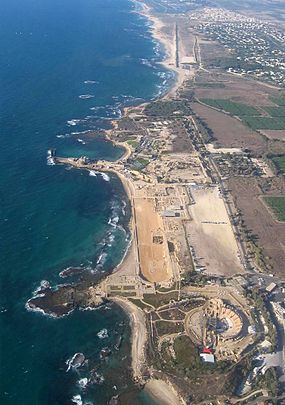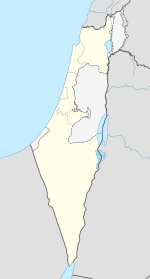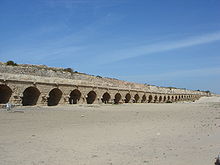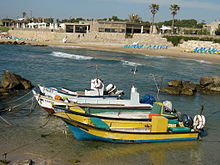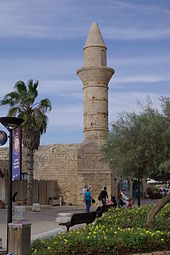- Caesarea Maritima
-
Caesarea Maritima
קיסריהLocation 
Coordinates 32°30′09″N 34°53′30″E / 32.5025060°N 34.8917670°E History Builder Herod the Great Periods Roman, Byzantine, Islamic, Crusader Site notes Condition ruin Ownership Israel Nature and Parks Authority Public access yes Website Caesarea National Park Caesarea Maritima (Greek: παράλιος Καισάρεια), Caesarea Palaestina from 133 CE onwards,[1] was a city and harbor built by Herod the Great about 25–13 BC. Today, its ruins lie on the Mediterranean coast of Israel about halfway between the cities of Tel Aviv and Haifa, on the site of Pyrgos Stratonos ("Straton's Tower") .[2] Caesarea Maritima was named to flatter the Caesar. The city was described in detail by the 1st century Roman Jewish historian Josephus.[3] The city became the seat of the Roman prefect soon after its foundation. The emperor Vespasian raised its status to that of a colonia. After the destruction of Jerusalem in 70 CE, Caesarea was the provincial capital of Iudaea Province before the change of name to Syria Palaestina in 134 CE, shortly before the Bar Kokhba revolt.[4] Caesarea was the "administrative capital" beginning in 6 CE.[5] In Byzantine times, Caesarea remained the capital, with brief interruption of Persian and Jewish conquest between 614 and 625. In the 630s, Arab Muslim armies had taken control of the region, keeping Caesarea as its administrative center. In the early 8th century, the Umayyad caliph Suleiman transferred the seat of government of the Jund Filastin from Caesarea to Ramla.
Contents
History
Roman era
Herod built his palace on a promontory jutting out into the sea, with a decorative pool surrounded by stoas. In 13 BC, Caesarea became the civilian and military capital of Iudaea Province and the official residence of the Roman procurators and governors, Pontius Pilatus, praefectus and Antonius Felix. Josephus describes the harbor as being as large as the one at Piraeus, the major harbor of Athens. Remains of the principal buildings erected by Herod and the medieval town are still visible today, including the city walls, the castle and a Crusader cathedral and church. Caesarea grew rapidly, becoming the largest city in Judea, with an estimated population of 125,000 over an urban area of 3.7 square kilometres (1.4 sq mi). In 66 CE, the desecration of the local synagogue led to the disastrous Jewish revolt.[6]
In 69, Vespasian declared it a colony and renamed it Colonia Prima Flavia Augusta Caesarea. In 70 CE, after the Jewish revolt was suppressed, games were held here to celebrate the victory of Titus. Many Jewish captives were brought to Caesarea Maritima and 2500 were slaughtered in Gladiatorial games.[7]
After the revolt of Simon bar Kokhba in 132, which ended with the destruction of Jerusalem and expulsion of Jews, Caesarea became the center of Early Christianity in Palestine.
Christian hub
See also: Early centers of Christianity#Caesarea and Bishop of CaesareaAccording to the Acts of the Apostles, Caesarea was first introduced to Christianity when Peter the apostle baptized Cornelius the Centurion, his household, and his soldiers.[8] This was the first time any Apostle had preached to the Gentiles and before Paul's first missionary journey. The Apostle Paul sought refuge there,[9] staying once at the house of Philip the Evangelist, and later being imprisoned at Caesarea (which was the capital of the Roman province) for two years before being sent to Rome.[10] The historical reliability of the Acts of the Apostles, the primary source for the Apostolic Age, is a major issue for biblical scholars and historians of Early Christianity.
The Apostolic Constitutions state that the first Bishop of Caesarea was Zacchaeus the Publican. According to the Catholic Encyclopedia, Caesarea became the metropolitan See. In the 3rd century Origen wrote his Hexapla and other exegetic and theological works while living there. The early church historian Eusebius was one of its bishops (315 - 318) in the early 4th century. Nicene Creed may have originated in Caesarea.
The main church, a martyrion (martyr's shrine) was built in the 6th century and sited directly upon the podium that had supported the Roman temple, as was a widespread Christian practice. Throughout the Empire, prominently-sited pagan temples were rarely left unconsecrated to the new rites: in time the Martyrion's site was re-occupied, this time by a mosque. The Martyrion was an octagon, richly re-paved and surrounded by small radiating enclosures. Archaeologists have recovered some foliate capitals that included representations of the Cross.
An elaborate government structure contained a basilica with an apse, where magistrates would have sat, for the structure was used as a hall of justice, as fragments of inscriptions detailing the fees that court clerks might claim attest. A well-preserved 6th century mosaic gold and colored glass table patterned with crosses and rosettes was found in 2005.[11] [12]
Theological library
Main article: Theological Library of Caesarea MaritimaThrough Origen and especially the scholarly presbyter Pamphilus of Caesarea, an avid collector of books of Scripture, the theological school of Caesarea won a reputation for having the most extensive ecclesiastical library of the time, containing more than 30,000 manuscripts: Gregory Nazianzus, Basil the Great, Jerome and others came to study there. The Caesarean text-type is recognized by scholars as one of the earliest New Testament types. The collections of the library suffered during the persecutions under the Emperor Diocletian, but were repaired subsequently by bishops of Caesarea.[13] It was noted in the 6th century, but Henry Barclay Swete[14] was of the opinion that it probably did not long survive the capture of Caesarea by the Saracens in 638, though a modern historian would attribute more destruction to its previous capture by the Sassanid Persians (in 614).
Arab rule
In 638 the city, capital of Byzantine Palestine and an important commercial and maritime center, was conquered by the Muslims, allegedly through the betrayal of a certain Yusef, who conducted a party of troops of Muawiyah through a "secret tunnel", perhaps the extensive Byzantine sewers, into the city.[15] The Persian historian al-Baladhuri, who offers the earliest Muslim account, merely states that the city was "reduced".[16] The 7th-century Coptic bishop John of Nikiû, mentions "the horrors committed in the city of Caesarea in Palestine".[17]
Crusader era
The walls remained, but within them the population dwindled and agriculture crept in among the ruins. When Baldwin I took the city in 1101/2, during the First Crusade, it was still very rich, nevertheless. A legend grew up that in this city was discovered the Holy Grail around which so much lore accrued in the next two centuries. The city was strongly refortified and rebuilt by the Crusaders. A lordship was created there, as was one of the four archbishoprics in the kingdom (see Archbishop of Caesarea). A list of thirty-six Latin bishops, from 1101 to 1496 has been reassembled by 19th century papal historians; the most famous of these is probably Heraclius. After that the Latin "Bishop of Caesarea" became an empty title. Saladin retook the city in 1187; it was recaptured by the Crusaders in 1191, and finally lost by them in 1265, this time to the Mamluks, who ensured that there would be no more battling over the site— where the harbor has silted in anyway— by razing the fortifications - in line with their practice in other formerly-Crusader coastal cities.
Sebastos harbor
When it was built in the 1st century BC, Sebastos Harbor ranked as the largest artificial harbor built in the open sea, enclosing around 100,000 m2.[18][19] King Herod built the two moles, or breakwaters, of the harbor between 22 and 15 BC,[20] and in 10/9 BC he dedicated the city and harbor to Caesar (Sebastos is Greek for Augustus).[21] The pace of construction was impressive considering its size and complexity. The moles were made of lime and pozzolana, a type of volcanic ash, set into a concrete underwater. Herod imported over 24,000 m3 pozzolana from Pozzuoli, Italy, to construct the 500 meter long southern breakwater and 275 meter long northern breakwater.[22] A shipment of this size would have required at least 44 shiploads of 400 tons each.[20] Herod also had 12,000 m3 of kurkar quarried to make rubble and 12,000 m3 of slaked lime mixed with the pozzolana.
Architects had to devise a way to lay the wooden forms for the concrete moles underwater. One technique was to drive stakes into the ground to make a box and then fill the box with pozzolana concrete bit by bit.[18] However, this method required many divers to hammer in the stakes underwater and it used large quantities of pozzolana. Another technique was a double planking method used in the northern breakwater. On land, carpenters would construct a box with beams and frames on the inside and a watertight, double-planked wall on the outside. This double wall was built with a 23 cm gap between the inner and outer layer.[23] Although the box had no bottom, it was buoyant enough to float out to sea because of the watertight space between the inner and outer walls. Once it was floated into position, pozzolana was poured into the gap between the walls and the box would sink into place on the seafloor and be staked down in the corners. The flooded inside area was then filled by divers bit by bit with pozzolana-lime mortar and kurkar rubble until it rose above sea level.[23]
On the southern breakwater, barge construction was used. The southern side of Sebastos was much more exposed than the northern side, requiring sturdier breakwaters. Instead of using the double planked method filled with rubble, the architects sank barges filled with layers of pozzolana concrete and lime sand mortar. The barges were similar to boxes without lids, and were constructed using mortise and tenon joints, the same technique used in ancient boats, to ensure they remained watertight. The barges were ballasted with 0.5 meters of pozzolana concrete and floated out to their position. Alternating layers of pozzolana based and lime based concretes were hand placed inside the barge to sink it and fill it up to the surface.[23]
At its height, Sebastos was one of the most impressive harbors of its time. It had been constructed on a coast that had no natural harbors and served as an important commercial harbor in antiquity, rivaling Cleopatra’s harbor at Alexandria. Josephus wrote: “Although the location was generally unfavorable, [Herod] contended with the difficulties so well that the solidity of the construction could not be overcome by the sea, and its beauty seemed finished off without impediment.”[24] However, there were underlying problems that led to its demise. Studies of the concrete cores of the moles have shown that the concrete was much weaker than similar pozzolana hydraulic concrete used in ancient Italian ports. For unknown reasons, the pozzolana mortar did not adhere as well to the kurkar rubble as it did to other rubble types used in Italian harbors.[22] Small but numerous holes in some of the cores also indicate that the lime was of poor quality and stripped out of the mixture by strong waves before it could set.[22] Also, large lumps of lime were found in all five of the cores studied at Caesarea, which shows that the mixture was not mixed thoroughly.[22] However, stability would not have been seriously affected if the harbor had not been constructed over a geological fault line that runs along the coast. Seismic action gradually took its toll on the breakwaters, causing them to tilt down and settle into the seabed.[24] Also, studies of seabed deposits at Caesarea have shown that a tsunami struck the area sometime between the 1st and 2nd centuries CE.[25] Although it is unknown if this tsunami simply damaged or completely destroyed the harbor, it is known that by the 6th century the harbor was unusable and today the moles rest over 5 meters underwater.[26]
Archaeology and reconstruction
Archaeological excavations in the 1950s and 1960s uncovered remains from many periods, in particular, a complex of Crusader fortifications and a Roman theatre. Other buildings include a temple dedicated to Caesar; a hippodrome rebuilt in the 2nd century as a more conventional theater; the Tiberieum, which has a limestone block with a dedicatory inscription.[27] This is the only archaeological find with an inscription mentioning the name "Pontius Pilatus"; a double aqueduct that brought water from springs at the foot of Mount Carmel; a boundary wall; and a 200 ft (60 m) wide moat protecting the harbour to the south and west. The harbor was the largest on the eastern Mediterranean coast. Worked directed by Robert Bull of Drew University is still in the process of publication while more recent work in the harbor directed by Robert Hohlfelder *U of Colorado, John Oleson of the U of Victoria, and the late Avner Raban has been largely published. Caesarea has recently become the site of what bills itself as the world's first underwater museum, where 36 points of interest on four marked underwater trails through the ancient harbor can be explored by divers equipped with waterproof maps.
See also
- List of megalithic sites
References
- ^ Flavius Josephus, Antiquitates Judaicae (ed. B. Niese)
- ^ Avner Raban and Kenneth G. Holum (1996) Caesarea Maritima: a retrospective after two millenia BRILL, ISBN 90-04-10378-3 p 54
- ^ Jewish Antiquities XV.331ff; The Jewish War I.408ff
- ^ Shimon Applebaum (1989) Judaea in Hellenistic and Roman Times: Historical and Archaeological Essays Brill Archive, ISBN 90-04-08821-0 p 123
- ^ A History of the Jewish People, H.H. Ben-Sasson editor, 1976, page 247: "When Judea was converted into a Roman province [in 6 CE, page 246], the Romans moved the governmental residence and military headquarters from Jerusalem to Caesarea.
- ^ http://www.sacred-destinations.com/israel/caesarea-history.htm accessed September 17, 2007
- ^ Kasher, Aryeh (1990) Jews and Hellenistic Cities in Eretz-Israel: Relations of the Jews in Eretz-Israel with the Hellenistic Cities During the Second Temple Period (332 BCE-70CE) Mohr Siebeck, ISBN 3-16-145241-0, p 311
- ^ Acts 10:1-31
- ^ Acts 9:26-30; 18:22; 21:8
- ^ Acts 23:23, 25:1-13
- ^ Unique glass mosaic unveiled after restoration in Caesarea
- ^ [1]
- ^ Jerome, "Epistles" xxxiv
- ^ Introduction to the Old Testament in Greek, pp 74-75.
- ^ Eric M. Meyers, Galilee Through the Centuries, ch. "The Fall of Caesarea Maritima", 1999:380ff.
- ^ The archaeological stratum representing the destruction is analyzed in the PhD dissertation of Cherie Joyce Lentzen, The Byzantine/Islamic Occupation of Caesarea Maritima as Evidenced Through the Pottery (Drew University 1983), noted by Meyer 1999:381 note 23.
- ^ Quoted in Meyers 1999:381.
- ^ a b Hohfelder, R. 2007. “Constructing the Harbour of Caesarea Palaestina, Israel: New Evidence from ROMACONS Field Campaign of October 2005.” International Journal of Nautical Archaeology 36:409-415
- ^ Votruba, G. 2007. “Imported Building Materials of Sebastos Harbour, Israel.” International Journal of Nautical Archaeology 36:325-335.
- ^ a b Votruba, G., 2007, Imported building materials of Sebastos Harbour, Israel, International Journal of Nautical Archaeology 36: 325-335.
- ^ Raban, A., 1992. Sebastos: the royal harbour at Caesarea Maritima - a short-lived giant, International Journal of Nautical Archaeology 21: 111-124.
- ^ a b c d Hohfelder, R. 2007. “Constructing the Harbour of Caesarea Palaestina, Israel: New Evidence from ROMACONS Field Campaign of October 2005.” International Journal of Nautical Archaeology 36:409-415.
- ^ a b c Brandon, C., 1996, Cements, Concrete, and Settling Barges at Sebastos: Comparisons with Other Roman Harbor Examples and the Descriptions of Vitruvius, Caesarea Maritima: A Retrospective after Two Millenia, 25-40.
- ^ a b Holum, K. 1988. King Herod’s Dream: Caesarea on the Sea. New York: Norton.
- ^ Reinhardt, E., Goodman, B., Boyce, J., Lopez, G., Hengstum, P., Rink, W., Mart, Y., Raban, A. 2006. “The Tsunami of 13 December A.D. 115 and the Destruction of Herod the Great’s Harbor at Caesarea Maritima, Israel.” Geology 34:1061-1064.
- ^ Raban, A., 1992, Sebastos: the royal harbour at Caesarea Maritima - a short-lived giant, International Journal of Nautical Archaeology 21: 111-124
- ^ Pilate Inscription
Further reading
- Avner Raban and Kenneth G. Holum, Caesarea Maritima: a retrospective after two millenia (Leiden, Brill, 1996).
- Clayton Miles Lehmann and Kenneth G. Holum, The Greek and Latin Inscriptions of Caesarea Maritima (Boston, American Schools of Oriental Research, 2000).
- J. Patrich, Caesarea in the Time of Eusebius, in: Sabrina Inowlocki & Claudio Zamagni (eds), Reconsidering Eusebius: Collected papers on literary, historical, and theological issues (Leiden, Brill, 2011) (Vigiliae Christianae, Supplements, 107).
External links
- Jewish Encyclopedia: Cæsarea by the Sea
- Catholic Encyclopedia: Caesarea Palaestinae
- PBS Frontline – Caesarea Maritima
- Archaeology:
- Photos:
Coordinates: 32°30′00″N 34°53′59″E / 32.5°N 34.89972°E
Second Journey of Paul the Apostle 1. Cilicia · 2. Derbe · 3. Lystra · 4. Phrygia · 5.Galatia · 6. Mysia (Alexandria Troas) · 7. Samothrace · 8. Neapolis · 9. Philippi · 9. Amphipolis · 10. Apollonia · 11. Thessalonica · 12. Beroea · 13. Athens · 14. Corinth · 15. Cenchreae · 16. Ephesus · 17. Syria · 18. Caesarea · 19. Jerusalem · 20. AntiochThird Journey of Paul the Apostle National parks of Israel Jerusalem District Bayt 'Itab · Canada Park · Castel · City of David National Park1 · Ein Hemed · Judaean Mountains · Tomb of Samuel1North District Achziv · Bar'am National Park · Beit Alfa Synagogue · Beit She'an · Beit She'arim · Belvoir Fortress · Capernaum · Chorazin · Gan HaShlosha · Hamat Gader · Hamat Tiberias · Harod Spring · Hermon National Park1 · Hexagons pool · Horns of Hattin · Hurshat Tal · Hurvat Minia · Kursi1 · Montfort Castle · Mount Arbel · Mount Tabor · Nimrod Fortress1 · Rosh HaNikra · Sde Amudim · Sussita · Tel Hazor · Tel Kedesh · Tel Megiddo · Tzalmon Stream · Tzippori · Yehi'am Fortress · Hula ValleyHaifa District Ancient Caesarea · HaSharon Park · Mount Carmel · Tel Shikmona · Nahal MearotCentral District Alexander stream · Arsuf · Hof HaSharon · Mazor Mausoleum · Migdal Afek · Palmachim beach · Rubin Stream · Sidna Ali · Tel Afek · Tel Gezer · Tzur Natan park · Yarkon National ParkSouthern District Ashkelon National Park · Avdat · Besor Stream · Beit Guvrin National Park · Ein Avdat · Ein Gedi · Eshkol Park · Mamshit · Masada · Monument to the Negev Brigade · Nitzana · Semekh caves · Shivta · Tel Arad · Tel Be'er Sheva · Tel Lachish · Tel ZafitJudea and Samaria Area Crusader sites in Israel State of Israel Abu Ghosh • Achziv • Acre • Arsuf • Ashkelon • Ateret Fortress • Azor • Bayt 'Itab • Beit Guvrin • Beit She'an • Belvoir • Burgata • Caesarea • Cafarlet • Château Pèlerin • Destroit • Givat Titora • Ein Hemed • Jerusalem • Khirbat Rushmiya • Margaliot • Mi'ilya • Migdal Afek • Montfort • Qalansawe • Qaqun • Qastal • Qula • Safed • Taibe • Tel Afek • Tel Hanaton • Tel Tzafit • Tel Tzova • Tel Yavne • Tiberias • Tzippori • Umm Khalid • Yehiam
Categories:- Roman aqueducts outside Rome
- Jews and Judaism in the Roman Empire
- Archaeological sites in Israel
- Crusader castles
- National parks of Israel
- Roman sites in Israel
- Populated places established in the 1st century BC
- Caesarea (Israel)
- New Testament cities
- Former populated places in Southwest Asia
- Cities and towns of the Byzantine Empire
- Maritime archaeology in Israel
- Judaea (Roman province)
Wikimedia Foundation. 2010.

